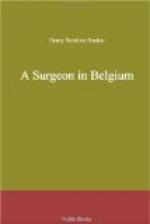The very next morning, while we were still at breakfast, the wounded began to arrive, and we never had another day in Antwerp that was not crowded with incident. The wounded almost always came in large batches, and the reason of this was the method of distribution adopted by the authorities. All the injured out at the front were collected as far as possible to one centre, where a train was waiting to receive them. There they remained until the train was sufficiently filled, when it brought them into the Central Station of Antwerp. At this point was established the distributing station, with a staff of medical officers, who arranged the destination of each man. Antwerp has a very complete system of electric trams, scarcely a street being without one, and of these full use was made for the transport of the wounded. Those who could sit went in ordinary cars, but for the stretcher cases there were cars specially fitted to take ordinary stretchers. A car was filled up with cases for one hospital, and in most cases it could deposit them at the door. It was an admirable method of dealing with them, simple and expeditious, and it involved far less pain and injury to the men than a long journey on an ambulance. In fact, we were only allowed in exceptional circumstances to bring in wounded on our cars, and it is obvious that it was a wise plan, for endless confusion would have been the result if anyone could have picked up the wounded and carried them off where they liked. Our cars were limited for the most part to carrying the injured to the various dressing-stations and to the train, and for these purposes they were always welcomed. They were soon well known at the trenches, and wherever the fighting was heaviest you might be sure to find one of them. Many were the hairbreadth escapes of which they had to tell, for if there were wounded they brought them out of danger, shells or no shells. And it says as much for the coolness of the drivers as for their good luck that no one was ever injured; for danger is halved by cool judgment, and a bold driver will come safely through where timidity would fail.
X. The Siege
It is difficult to say exactly when the Siege of Antwerp began. For weeks we heard the distant boom of the guns steadily drawing nearer day by day, and all night the sky was lit up by distant flashes. But so peculiar was the position of Antwerp that it was not till the last ten days that our life was seriously affected, and not till the very end that communication with our friends and the getting of supplies became difficult. Our first real domestic tragedy was the destruction of the waterworks on the 30th of September. They lay just behind Waelhem, some six miles south of Antwerp, and into them the Germans poured from the other side of Malines a stream of 28-centimetre shells, with the result that the great reservoir burst. Until one has had to do without a water-supply in




